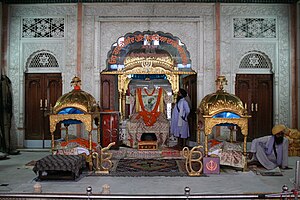Sikhism in Bihar
 Takht Sri Patna Sahib (Patna Sahib) in Patna is one of the holiest shrine of Sikhism. | |
| Total population | |
|---|---|
| '23,779' (0.02%) (2011) | |
| Regions with significant populations | |
| Most significant populations in Patna · | |
| Languages | |
| Punjabi • Hindi • | |
| Religion | |
| Sikhism |
is the fourth largest religion in India contributing 0.02% of the population and has existed since late 15th century. The Sikhs are predominantly located in Patna, but also in many other districts of Bihar. The capital of Bihar, Patna is one of the holiest city in Sikhism and one of the Five Takhts of the Sikhism is located Patna .
History[edit]
Founder of Sikhism Guru Nanak visited Patna during 1509. Gurdwara Pahila Bara (aka Gurdwara Ghai Ghat) was built on temporary residence of Guru Nanak Dev. Guru Teg Bahadur also visited many places in Bihar in the mid-1660s. Gurdwara Handi Sahib was built in the memory of Guru Teg Bahadur. As Guru Teg Bahadur with Mata Gujri and Bala Preetam stayed here in 1728. The tenth Guru of the Sikhs, Guru Gobind Singh, was born at Patna in 1666. Guru Gobind Singh spent the early part of his childhood Patna and then moved to Anandpur. Guru Gobind Singh used to play with his playmates on the bank of the Ganges and later Gurdwara Gobind Ghat, Guru ka Bagh, and Gurdwara Bal Leela built around these places place. Guru Gobind Singh in his childhood used to play at Gurdwara Bal Leela is also known as Maini Sangat. In Hindu mythology, this is the place where Guru Gobind Singh threw his gold bangle (kangan) and passed on the knowledge of Sri Guru Granth Sahib Ji to Pandit Shiv Dutt, a devotee of Sri Ram Chandra.[1] Later, it is also known as Gurdwara Kangan Ghat. Patna Saheb, as it is called by Sikhs, is one of the holiest pilgrimage in Sikhism. Takht Shri Harmandir Saheb, one of the Five Takhts of Sikhism, was built by Sikh King Ranjit Singj at the birthplace of Guru Gobind Singh. Sikhism is an important religion taught in the schools and universities of Bihar.
People[edit]

Agrahari Sikh is a Sikh community found in eastern India including state West Bengal, Bihar and Jharkhand. Agrahari Sikhs, also known as Bihari Sikhs, have existed for centuries in Bihar and Jharkhand.[2] Bihari Sikhs share their culture with the local Bihari community. The men generally wear the local dhoti and women wear the Sari. They also celebrate cultural festivals such as the Chath festival.[3]
Pilgrimage[edit]
- Takht Shri Harmandir Saheb
- Gurdwara Pahila Bara
- Gurdwara Gobind Ghat
- Gurdwara Guru ka Bagh
- Gurdwara Bal Leela
- Gurdwara Handi Sahib
- Gurdwara Taksali Sangat
- Gurdwara Chacha Phaggu Mal
- Gurdwara Pakki Sangat
- Gurdwara Bari Sangat
- Sri Guru Tegh Bahadur Ji Chauki.
- Prakash Punj
Demography[edit]
| Historical Sikh Population | ||
|---|---|---|
| Year | Pop. | ±% |
| 1951 | - | — |
| 1961 | - | — |
| 1971 | - | — |
| 1981 | - | — |
| 1991 | - | — |
| 2001 | 20,780 | — |
| 2011 | 23,779 | +14.4% |
| Source: census of India | ||
As per 2011 census, Bihar's Sikh population stands at only 23,779, which is only 0.02% of the sate's total population. There was 20,780 sikhs in Bihar as per 2001 census.
See also[edit]
Further reading[edit]
- Fauja, S., & Talib, Gurbachan Singh (1996). Guru Tegh Bahadur: Martyr and teacher. Patiala: Punjabi University.
References[edit]
- ↑ "Archimedespress Books". 2015-12-12. Archived from the original on 2015-12-12. Retrieved 2020-04-06.
- ↑ "Sikhs and Sikhism in Eastern and North-Eastern India". Institute of Sikh Studies.
- ↑ Calcutta Mosaic: Essays and Interviews on the Minority Communities of Calcutta : edited by Nilanjana Gupta, Himadri Banerjee, Sipra Mukherjee [1]
External links[edit]
- The Sikh Foundation International – Inspire, Engage & Educate (English) -
- Sikhismus | Sikh Religion | Sikhi | DISR - Deutsches Informationszentrum für Sikh Religion informiert | Gurbani | Gurmat (German & English)
This article "Sikhism in Bihar" is from Wikipedia. The list of its authors can be seen in its historical and/or the page Edithistory:Sikhism in Bihar. Articles copied from Draft Namespace on Wikipedia could be seen on the Draft Namespace of Wikipedia and not main one.
